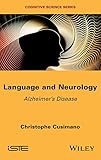Language and neurology : Alzheimer's disease / Christophe Cusimano.
Contributor(s): Cusimano, Christophe [editor.]
Language: English Publisher: Hoboken : ISTE Ltd / John Wiley and Sons Inc, 2020Description: online resourceContent type: text Media type: computer Carrier type: online resourceISBN: 9781786306623Genre/Form: Electronic books.Online resources: Full text is available at Wiley Online Library Click here to view.| Item type | Current location | Home library | Call number | Status | Date due | Barcode | Item holds |
|---|---|---|---|---|---|---|---|
 EBOOK
EBOOK
|
COLLEGE LIBRARY | COLLEGE LIBRARY | 612.82336 L2692 2020 (Browse shelf) | Available | CL-52880 |
Browsing COLLEGE LIBRARY Shelves Close shelf browser

|

|

|

|
No cover image available | No cover image available |

|
||
| 612.82 St34 1974 Motivation and emotion / | 612.82 T377 1993 The brain: a neuroscience primer / | 612.82336 K9593 2023 Introduction to neurolinguistics / | 612.82336 L2692 2020 Language and neurology : Alzheimer's disease / | 612.84 C8818 2014 Visual ecology | 612.84 H88 2008 Human body : pushing the limits : sight & strength | 612.94 Se13 2018 Topographical and pathotopographical medical atlas of the chest, abdomen, lumbar region, and retroperitoneal space / |
Includes index.
Christophe Cusimano is Professor of French linguistics and a member of the Prague Linguistic Circle. He teaches and conducts his research in semantics at the Institute of Romanticism of the Masaryk University in Brno, Czech Republic.
Table of contents
Acknowledgments vii
Introduction ix
Chapter 1. Linguistics, Language Pathologies and Alzheimer’s Disease: A Brief History 1
1.1. Gagnepain’s theory of mediation: an approach to pathological speech on its own terms 2
1.2. “Looking for help from linguistics”: other (rare) resources 10
Chapter 2. Alzheimer’s Disease: General Symptoms and Language Impairments 17
2.1. General symptoms 18
2.2. Language-related problems 25
Chapter 3. Cognitive Testing: The Key to Diagnosing Memory Pathologies 31
3.1. Definitions of psychometric tests 31
3.2. Test types 34
3.3. Intelligence tests: a starting point 35
3.4. The mysterious test 38
3.5. Postulates on verbal language in cognitive testing 39
3.6. Verbal and non-verbal cognitive tests 43
3.6.1. Non-verbal tests 44
3.6.2. Basic verbal tests: naming, designation and matching 48
3.6.3. Tests using idiomatic expressions 54
3.6.4. Barbizet’s test: “The Lion’s Tale” 58
3.7. Tests and context(s) 66
3.8. Absence of a cultural dimension in cognitive testing 70
3.8.1. First-generation North African patients in France 70
3.8.2. Erasure of Czech/Slovak cultural disparities 71
3.8.3. Connecting cognition and culture: origins and perspectives 72
3.9. Summary: rewriting tests 73
Chapter 4. Analyzing the Speech of Alzheimer’s Patients: Methods and Perspectives 79
4.1. An eclectic range of approaches 79
4.2. Patient–physician dialog and autobiographies: microsemantic analysis 89
4.3. Analyzing patient discourse: perspectives 106
4.3.1. Recursion, circularity and sequences: finding meaning through analysis grids 106
4.3.2. A multi-channel approach 113
4.3.3. Confabulations: “from minor distortion to bizarre tales”17 117
Conclusion 129
Appendices 135
Appendix 1. Interview Transcriptions: The Lion’s Tale Test 137
Appendix 2. English Translations for Chapter 4 159
References 165
Index 173
This book questions the relationship and compatibility between current beliefs in neurology and contemporary textual linguistic theories, interpretative semantics and discourse analysis.
It begins with a critical examination of the screenings for Alzheimers type dementia through cognitive testing, particularly screenings where language is used. It then analyzes the various linguistic properties (morphological, syntactic and semantic) of the speech of Alzheimers patients, which can be troubling for both caregivers and their environment in general.
More than a synthesis of critical linguistic reflections, Language and Neurology provokes a fruitful reflection through adjustments suggested by the acquired knowledge of textual semantics.

There are no comments for this item.